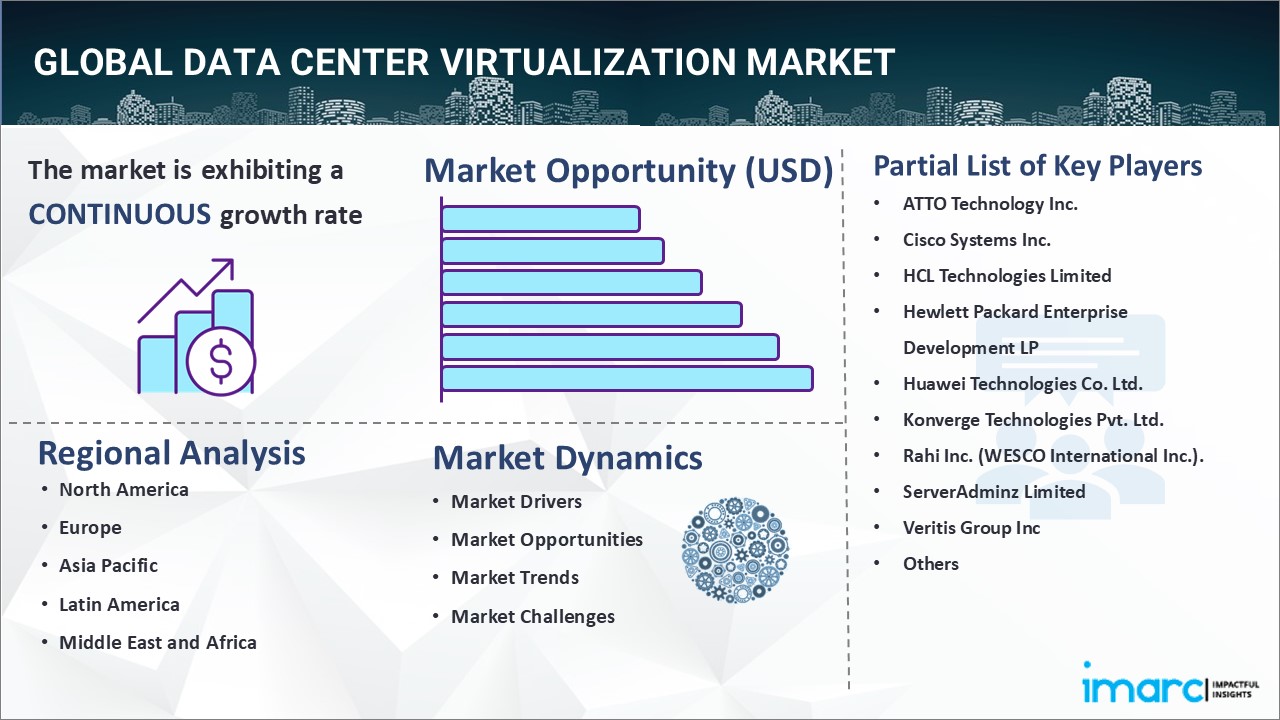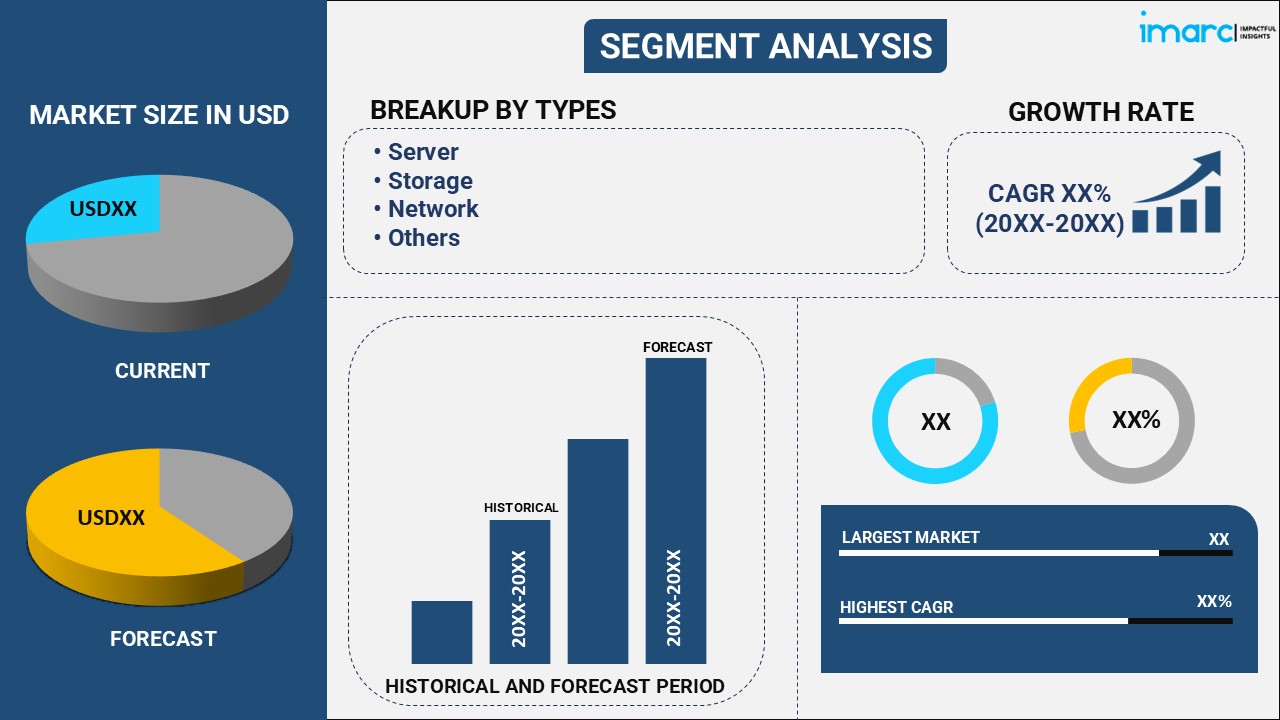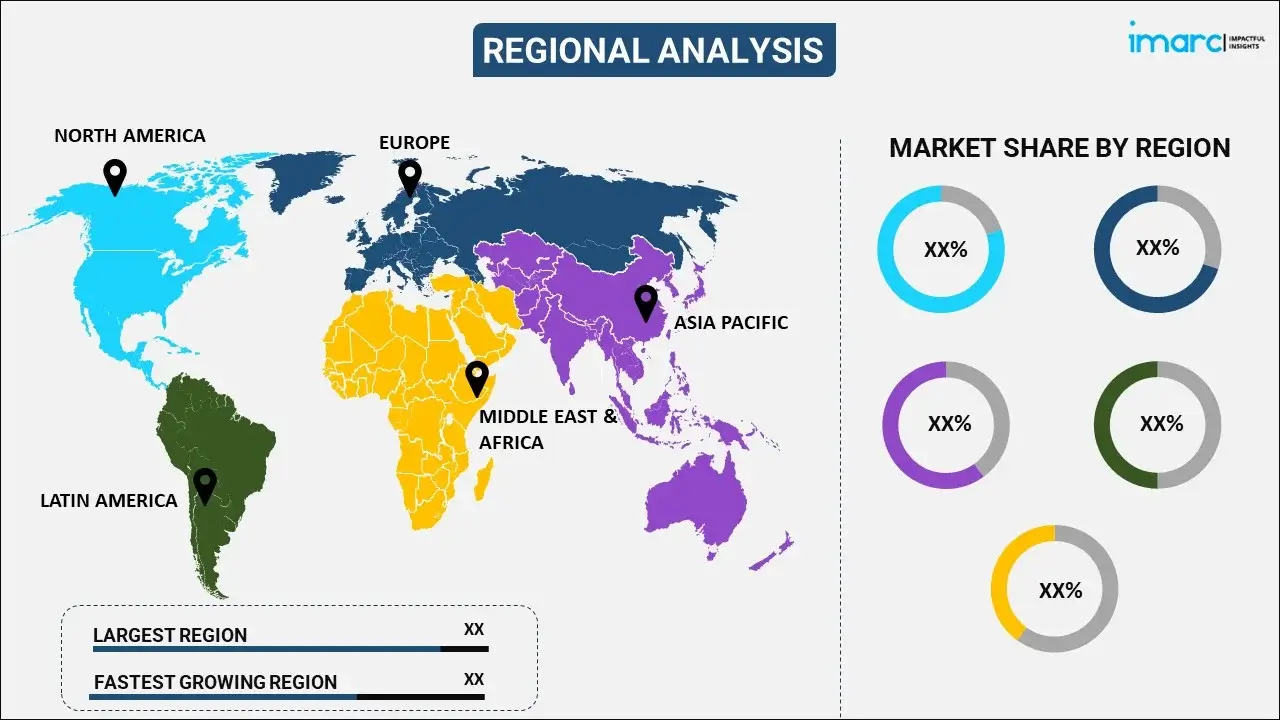
Data Center Virtualization Market Report by Type (Server, Storage, Network, Desktop, Application, and Others), Component (Software, Service), Organization Size (Large Enterprises, Small and medium-sized enterprises (SMEs)), End Use (Banking Financial Services and Insurance, IT and Telecommunication, Manufacturing and Automotive, Government, Healthcare, Education, Retail and SCM, Media and Entertainment, and Others), and Region 2025-2033
Market Overview:
The global data center virtualization market size reached USD 11.7 Billion in 2024. Looking forward, IMARC Group expects the market to reach USD 37.8 Billion by 2033, exhibiting a growth rate (CAGR) of 13.91% during 2025-2033. The rising need to reduce cost and enhance operational efficiency among organizations, the increasing focus on business continuity and disaster management, and the surging need to consolidate and centralize data centers are some of the major factors propelling the market.
|
Report Attribute
|
Key Statistics |
|---|---|
|
Base Year
|
2024 |
|
Forecast Years
|
2025-2033
|
|
Historical Years
|
2019-2024
|
| Market Size in 2024 | USD 11.7 Billion |
| Market Forecast in 2033 | USD 37.8 Billion |
| Market Growth Rate 2025-2033 | 13.91% |
Data center virtualization is a technology that enables the consolidation and abstraction of physical computing resources within a data center environment. It creates virtual instances of servers, storage, networking devices, and other infrastructure components, allowing them to be dynamically allocated, managed, and utilized by multiple applications or users. Data center virtualization enhances resource utilization, scalability, and flexibility while reducing costs and simplifying management by decoupling the underlying hardware from the software. The solution also allows organizations to optimize their infrastructure, streamline operations, and achieve greater efficiency and agility in meeting their computing needs.

The rising organizational need to minimize operational costs is fueling the demand for data center virtualization. The platform helps in reducing hardware costs by consolidating multiple servers onto a single virtualized server, leading to lower expenses for infrastructure maintenance and energy consumption. In addition to this, virtualization enables efficient utilization of computing resources, such as CPU, memory, and storage, by dynamically allocating them based on demand, which is propelling its adoption across various industrial verticals aiming to optimize their resources and reduce wastage. Moreover, the widespread product adoption, due to its offering of enhanced scalability, flexibility, and agility, enabling businesses to accommodate changing workloads and quickly adapt to increasing demands, is presenting remunerative growth opportunities for the market. Furthermore, the increasing adoption of cloud computing and the expanding demand for server, storage, network, and desktop virtualization are positively impacting the market growth.
Data Center Virtualization Market Trends/Drivers:
Growing need to reduce operational costs and enhance the business agility of enterprises
The need to lower operational costs and enhance the business agility of enterprises is one of the main factors driving the data center virtualization market. Virtualization enables organizations to reduce hardware costs, energy consumption, and maintenance costs, which, in turn, minimizes operational costs. Additionally, virtualization enables organizations to quickly provision and de-provision resources, which enhances business agility. In addition to this, the surging product deployment due to its ability to scale resources based on demand, ensuring efficient resource allocation, is contributing to the market growth. Concurrent with this, virtualization streamlines management tasks, reduces administrative overhead, and improves overall operational efficiency, which is acting as another significant growth-inducing factor.
Rising demand for unified and centralized data center administration
The surging demand for unified and centralized data center administration is a key driver of the market growth. Unified and centralized data center administration allows organizations to manage their virtualized infrastructure from a single interface. As a result, the growing need to streamline management processes, eliminate the need for multiple management tools, and reduce complexity within organizations, are aiding in market expansion. Moreover, the growing demand for improved source utilization, centralized security management and compliance enforcement, and overall cost reduction is presenting remunerative opportunities for the market. Concurrent with this, unified administration provides comprehensive visibility into the virtualized infrastructure, enabling quicker troubleshooting and performance optimization, which is further impelling its adoption across various industries.
Increasing emphasis on business continuity and disaster recovery
Data center virtualization plays a crucial role in ensuring business continuity and providing robust disaster recovery solutions. Virtualization enables the replication of virtual machines across multiple physical servers or data centers, creating resilient architectures. Moreover, in the event of a server failure or a disaster, virtual machines can be quickly restored or migrated to alternate locations, minimizing downtime and data loss. On account of these factors, there has been a rising adoption of data center virtualization across various industrial sectors. Besides this, the increasing demand to automate failover and recovery processes for enhancing the reliability and availability of critical business applications and services is contributing to the market growth. In addition to this, the emerging product employment for their features, such as snapshots, backups, and replication that enable efficient data protection and recovery mechanisms, is creating a favorable outlook for the market.
Data Center Virtualization Industry Segmentation:
IMARC Group provides an analysis of the key trends in each segment of the global data center virtualization market report, along with forecasts at the global, regional, and country levels from 2025-2033. Our report has categorized the market based on type, component, organization size, and end use.
Breakup by Type:

- Server
- Storage
- Network
- Desktop
- Application
- Others
Server is dominating the data center virtualization
The report has provided a detailed breakup and analysis of the data center virtualization market based on the type. This includes server, storage, network, desktop, application, and others. According to the report, server represented the largest segment.
Server virtualization is a key driver of data center virtualization growth. The expanding product utilization across various organizations to optimize resource utilization, reduce hardware costs, and enhance operational efficiency by consolidating multiple physical servers onto a single virtualized server is positively impacting the market growth. Moreover, the proliferation of cloud services, mobile devices, and the IoT is generating a growing demand for efficient network virtualization solutions to support the connectivity requirements of modern data centers. Furthermore, as businesses strive for efficient IT infrastructure and the ability to adapt to evolving demands, the demand for different types of data center virtualization continues to rise, aiding in market expansion.
Breakup by Component:
- Software
- Service
Software hold a larger share in data center virtualization market
A detailed breakup and analysis of the data center virtualization market based on the component has also been provided in the report. This includes software and service. According to the report, software accounted for the largest market share.
The increasing demand for data center virtualization software is fueled by its ability to provide the necessary infrastructure and management tools for virtualized environments. Besides this, these software solutions offer features like live migration, workload balancing, and centralized management, which makes them highly appealing among organizations looking to save costs and optimize business processes. In addition to this, continuous product innovations and technological advancements, such as the development of virtualization software with evolved functionalities and compatibility with emerging technologies, are favoring the market growth.
Breakup by Organization Size:
- Large enterprises
- Small and medium-sized enterprises (SMEs)
Large enterprises are dominating the data center virtualization
The report has provided a detailed breakup and analysis of the data center virtualization market based on the organization size. This includes large enterprises, and small and medium-sized enterprises (SMEs). According to the report, large enterprises represented the largest segment.
The increasing product demand across large enterprises that have complex and diverse IT infrastructures is positively impacting the market growth. Moreover, data center virtualization allows businesses to optimize resource utilization, enhance scalability, and improve operational efficiency, which, in turn, is propelling their adoption across various industrial verticals. Furthermore, the platform is gaining popularity among SMEs with cost-cutting needs since virtualization provides enhanced security by lowering the number of required hardware. The systems automatically return to their original state if the system is compromised or tampered with, thus offering a high level of security.
Breakup by End Use:
- Banking Financial Services and Insurance
- IT and Telecommunication
- Manufacturing and Automotive
- Government
- Healthcare
- Education
- Retail and SCM
- Media and Entertainment
- Others
IT and Telecommunication hold a larger share in data center virtualization
A detailed breakup and analysis of the data center virtualization market based on the end use has also been provided in the report. This includes banking financial services and insurance, IT and telecommunication, manufacturing and automotive, government, healthcare, education, retail and SCM, media and entertainment, and others. According to the report, IT and telecommunication accounted for the largest market share.
The large-scale product employment in banking, financial services and insurance (BFSI) organizations to enhance operational efficiency, scalability, security, and compliance with regulatory requirements is creating a positive outlook for market expansion. In addition to this, the bolstering growth of IT and telecommunication, wherein data center virtualization is employed in optimizing resource utilization, improving service delivery, and enhancing scalability, is acting as another significant growth-inducing factor. Furthermore, data center virtualization is widely employed in supporting supply chain management, facilitating remote monitoring and enabling efficient collaboration across locations.
Breakup by Region:

- North America
- United States
- Canada
- Europe
- Germany
- France
- United Kingdom
- Italy
- Spain
- Russia
- Others
- Asia Pacific
- China
- Japan
- India
- South Korea
- Australia
- Indonesia
- Others
- Latin America
- Brazil
- Mexico
- Others
- Middle East and Africa
North America exhibits a clear dominance in the market, accounting for the largest data center virtualization market share
The report has also provided a comprehensive analysis of all the major regional markets, which include North America (the United States and Canada); Europe (Germany, France, the United Kingdom, Italy, Spain, Russia, and others); Asia Pacific (China, Japan, India, South Korea, Australia, Indonesia, and others); Latin America (Brazil, Mexico, and others); and the Middle East and Africa. The proliferation of numerous technology-driven industries and the presence of highly developed IT infrastructure in North American is creating a positive outlook for market expansion. Moreover, the rising focus on data security and business continuity in the region is fueling the adoption of virtualization technologies to provide robust disaster recovery solutions. Apart from this, Europe has a diverse range of industries, including finance, manufacturing, healthcare, and telecommunications, which are increasingly adopting virtualization to optimize their IT infrastructure. Furthermore, the implementation of stringent data protection regulations, such as the General Data Protection Regulation (GDPR) in the region, is strengthening the market growth.
Competitive Landscape:
The global Data Center Virtualization market has a highly competitive landscape, with several key players competing to gain market share and drive innovation in the industry. The competitive dynamics are shaped by factors such as technological advancements, strategic partnerships, product portfolio, customer base, and geographical presence. Major technology companies offer comprehensive data center virtualization solutions, including hypervisors, management software, and related services. They have established strong market positions and benefit from their extensive customer base and brand recognition. Apart from these major players, there are several smaller companies and niche players that focus on specific aspects of data center virtualization, such as security, automation, or specialized virtualization technologies. The intense competition, continuous product development, and strategic collaborations will bolster the market growth during the forecasted period.
The report has provided a comprehensive analysis of the competitive landscape in the global data center virtualization market. Detailed profiles of all major companies have also been provided. Some of the key players in the global data center virtualization market include:
- ATTO Technology Inc.
- Cisco Systems Inc.
- HCL Technologies Limited
- Hewlett Packard Enterprise Development LP
- Huawei Technologies Co. Ltd.
- Konverge Technologies Pvt. Ltd.
- Rahi Inc. (WESCO International Inc.).
- ServerAdminz Limited
- Veritis Group Inc
- VMware Inc.
Recent Developments:
- In March 2023, Huawei Technologies Co. Ltd. unveiled Huawei OpenLab 3.0 Asia-Pacific, an upgrade of its Singapore R&D operations aimed at adapting its solutions to the specific needs of the region.
- In June 2023, HCLTech, announced the launch of a state-of-the-art test lab in Chennai, India to enable global telecom infrastructure original equipment manufacturers (OEMs), testing and validating 5G solutions.
- In September 2023, Wesco International announced its agreement to acquire Rahi Systems Holdings, Inc., a privately held company headquartered in Fremont, California for $217 million.
Data Center Virtualization Market Report Scope:
| Report Features | Details |
|---|---|
| Base Year of the Analysis | 2024 |
| Historical Period | 2019-2024 |
| Forecast Period | 2025-2033 |
| Units | Billion USD |
| Scope of the Report | Exploration of Historical and Forecast Trends, Industry Catalysts and Challenges, Segment-Wise Historical and Predictive Market Assessment:
|
| Types Covered | Server, Storage, Network, Desktop, Application, Others |
| Components Covered | Software, Service |
| Organization Sizes Covered | Large Enterprises, Small and Medium-sized Enterprises (SMEs) |
| End Uses Covered | Banking Financial Services and Insurance, IT and Telecommunication, Manufacturing and Automotive, Government, Healthcare, Education, Retail and SCM, Media and Entertainment, Others |
| Regions Covered | Asia Pacific, Europe, North America, Latin America, Middle East and Africa |
| Countries Covered | United States, Canada, Germany, France, United Kingdom, Italy, Spain, Russia, China, Japan, India, South Korea, Australia, Indonesia, Brazil, Mexico |
| Companies Covered | ATTO Technology Inc., Cisco Systems Inc., HCL Technologies Limited, Hewlett Packard Enterprise Development LP, Huawei Technologies Co. Ltd., Konverge Technologies Pvt. Ltd., Rahi Inc. (WESCO International Inc.)., ServerAdminz Limited, Veritis Group Inc, VMware Inc., etc. |
| Customization Scope | 10% Free Customization |
| Post-Sale Analyst Support | 10-12 Weeks |
| Delivery Format | PDF and Excel through Email (We can also provide the editable version of the report in PPT/Word format on special request) |
Key Questions Answered in This Report:
- How has the global data center virtualization market performed so far, and how will it perform in the coming years?
- What are the drivers, restraints, and opportunities in the global data center virtualization market?
- What is the impact of each driver, restraint, and opportunity on the global data center virtualization market?
- What are the key regional markets?
- Which countries represent the most attractive data center virtualization market?
- What is the breakup of the market based on the type?
- Which is the most attractive type in the data center virtualization market?
- What is the breakup of the market based on the component?
- Which is the most attractive component in the data center virtualization market?
- What is the breakup of the market based on the organization size?
- Which is the most attractive organization size in the data center virtualization market?
- What is the breakup of the market based on the end use?
- Which is the most attractive end use in the data center virtualization market?
- What is the competitive structure of the global data center virtualization market?
- Who are the key players/companies in the global data center virtualization market?
Key Benefits for Stakeholders
- IMARC’s report offers a comprehensive quantitative analysis of various market segments, historical and current market trends, market forecasts, and dynamics of the data center virtualization market from 2019-2033.
- The research study provides the latest information on the market drivers, challenges, and opportunities in the global data center virtualization market.
- The study maps the leading, as well as the fastest-growing, regional markets. It further enables stakeholders to identify the key country-level markets within each region.
- Porter's five forces analysis assist stakeholders in assessing the impact of new entrants, competitive rivalry, supplier power, buyer power, and the threat of substitution. It helps stakeholders to analyze the level of competition within the data center virtualization industry and its attractiveness.
- Competitive landscape allows stakeholders to understand their competitive environment and provides an insight into the current positions of key players in the market.
Need more help?
- Speak to our experienced analysts for insights on the current market scenarios.
- Include additional segments and countries to customize the report as per your requirement.
- Gain an unparalleled competitive advantage in your domain by understanding how to utilize the report and positively impacting your operations and revenue.
- For further assistance, please connect with our analysts.
 Request Customization
Request Customization
 Speak to an Analyst
Speak to an Analyst
 Request Brochure
Request Brochure
 Inquire Before Buying
Inquire Before Buying




.webp)




.webp)












